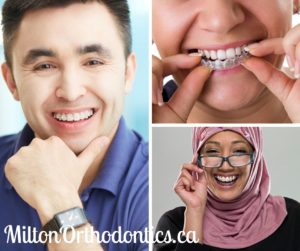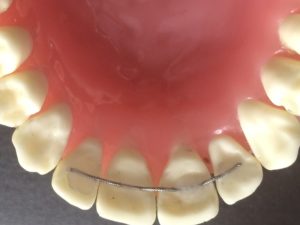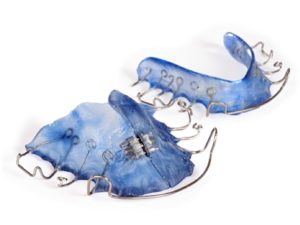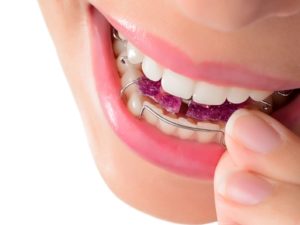What are Treatments?
Treatment Options are orthodontic techniques recommended to solve teeth or bite problems.
There are many treatment options these days, from clear aligners to modern braces. They each have their uses. Dr. Berka has the specialized knowledge to identify and plan for all the variables in your mouth. We take your unique needs and wishes into consideration, too, when recommending the right treatment option for you. As a certified orthodontist, Dr. Berka has the knowledge of the full range of orthodontic appliance “tools.” She knows what to use and when to use it because at Milton Orthodontics, we work with these tools every day.
You may see six crooked front teeth. An orthodontist sees the cause of crooked teeth in three dimensions. Orthodontists, like Dr. Eva Berka, use their education, experience and expertise to delve deep to discover the root of your orthodontic problem. Armed with a diagnosis that takes all factors into account, orthodontists can plan your solution—one that delivers a healthy, attractive smile and a lasting result.
 Sure, you want a dazzling smile. Your orthodontist wants that for you, too—and treatment results that last. You deserve the best—a good bite and a healthy, beautiful smile. Book a consultation with Milton Orthodontics for your oral health, your happiness and your smile.
Sure, you want a dazzling smile. Your orthodontist wants that for you, too—and treatment results that last. You deserve the best—a good bite and a healthy, beautiful smile. Book a consultation with Milton Orthodontics for your oral health, your happiness and your smile.
Why Should You See a Certified Orthodontist?
Orthodontics is a specialized branch of dentistry. An orthodontist is an expert in the diagnosing, preventing and treating dental and facial irregularities, or “malocclusion,” which means “bad bite.” Orthodontists are skilled in treatments that will bring teeth, lips and jaws into proper alignment.
Orthodontists do not focus only on cosmetics, but they treat and prevent physical health problems related to facial, jaw and tooth misalignment. Getting orthodontic treatment can prevent bone destruction, headaches and speech impairments.
In Canada, a certified Orthodontist must first attend university–usually working towards a Bachelor of Science. Once anywhere from 3-5 years of undergraduate university is completed, he/she must then complete a four year program at a dental school in university becoming a general dentist (DDS). Once he/she becomes a general dentist, he/she completes an additional two or three years in graduate dental school while he/she specializes in Orthodontics. Dr. Berka completed 11 years of university training to become a certified Orthodontist!
Learn more about Dr. Eva Berka’s education and training.

Adult Treatments
You are never too old for a beautiful smile! The movement of teeth can be accomplished at any age if your gums and supporting bone are healthy. Orthodontic treatment at later stages in life can dramatically improve your personal appearance and self-esteem. Improving the health of your teeth and gums is especially important as an adult. With orthodontics you can improve the positions of your teeth for periodontal health, as well as aid in the preparation for the placement of crowns, bridges or implants.
 Some adults never received orthodontic treatment as children to correct problems such as crooked or crowded teeth, overbites and underbites, incorrect jaw position or jaw joint disorders. If left untreated, these problems can result in tooth decay, gum disease, headaches, as well as speaking, biting or chewing problems.
Some adults never received orthodontic treatment as children to correct problems such as crooked or crowded teeth, overbites and underbites, incorrect jaw position or jaw joint disorders. If left untreated, these problems can result in tooth decay, gum disease, headaches, as well as speaking, biting or chewing problems.
Is Orthodontic Treatment Different for Adults?
Like children, adults can receive the same benefit of an improved smile and oral health from wearing braces. However, since adults are no longer growing, treatment may take slightly longer and treatment options may be different than for children or teenagers. The average adult wears braces or Invisalign aligners for 18 months to three years. After treatment is completed, retainers need to be worn to maintain the results of the treatment.
The number of adults in our office is growing. About 15-20% of our patients are adults at Milton Orthodontics. Braces technology has advanced significantly since the 80’s, 90s. Today there are a many options that adults have to choose from : metal braces, ceramic(clear) braces or Invisalign aligners.
At your initial consultation with Dr. Berka it would be a good opportunity to ask questions about your orthodontic treatment such as:
View Our Adult Brace Photo Gallery
To learn more about wearing braces as an adult see miltonadultbraces.com
Early Treatment
An Orthodontist can enhance your smile at any age, but there is an optimal age to begin treatment. The American Association Of Orthodontist recommends that the initial orthodontic evaluation should occur at the first sign of orthodontic problems or no later than age 7. There are different philosophies regarding when orthodontic treatment should begin. Evaluation or an assessment may occur, however at this early age, orthodontic treatment is not always necessary. Monitoring the growing and eruption patterns of the teeth as well as jaw growth and development helps in planning the most optimal time to begin treatment. There are, however, certain patients who highly benefit from early treatment-see below. An early assessment at the age of 7 is, therefore, recommended.
Advantages Of Early Treatment

Why Should Malocclusions (a bad bite) Be Treated?
According to studies by the Association of Orthodontists, untreated malocclusions, bad bites can result in a variety of problems:
Dr. Eva Berka offers free consultations. Book your consultation today!
Your Braces Are Coming Off!!! Celebrate and Smile!
Once your braces are removed, fixed and/or removable retainers are placed. Depending on your needs, these retainers will be worn for a specified amount of time. Patients that have had treatment by Dr. Berka are covered for a lifetime of retention. This means that you can come to our office anytime after your orthodontic treatment is completed to monitor/check your retainers or address any questions or concerns. This retention follow up truly sets our office apart from others, who may monitor into retention for only 2-3 years.
Different Types of Retainers
At your “brace removal” or deband appointment, special instructions will be given to each patient (with his/her parent/guardian, if applicable) on care of your retainers, types of retainers and follow up retention appointments. In order to maintain your beautiful smile, it is important to follow these instructions.
What is a Fixed Retainer?
This type of retainer is bonded to the inside surface of your teeth. It is invisible to others. It is typically fixed to the back surfaces of the lower and upper front teeth. This retainer stays in your mouth permanently to keep the front teeth straight.
What are Removable Retainers?
This type of retainer can be taken in and out. It is typically worn for the top teeth and will be worn, in general, nighttimes only.

Learn more about Retainers See Milton Retainers